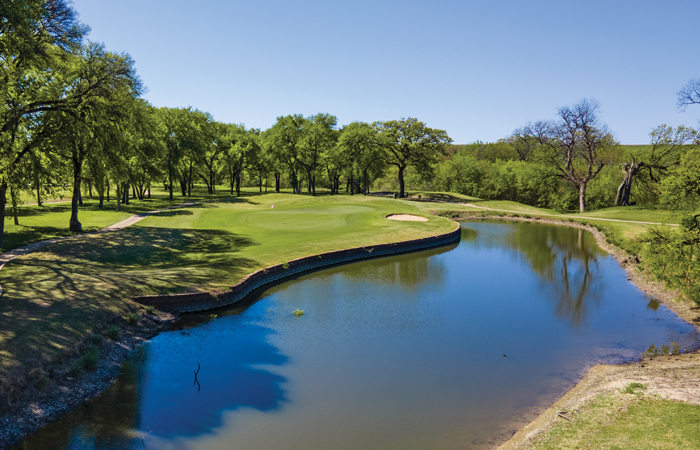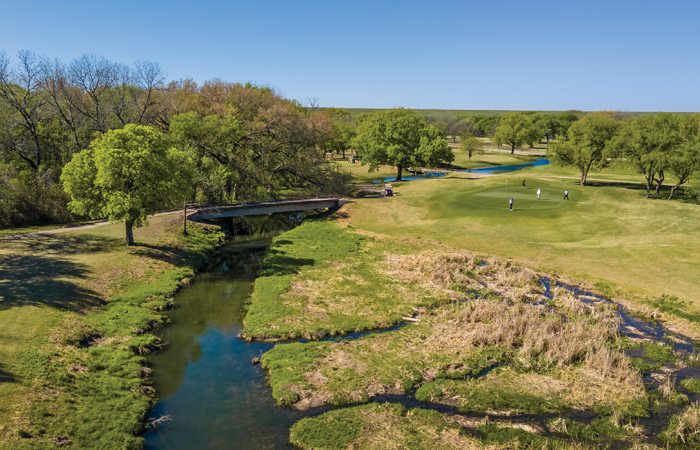Fort Worth has really stepped up its municipal golf game over the last several years. The renovation of Rockwood, which was officially completed in 2017, and the planned, long overdue renovation of Meadowbrook Golf Course, which will begin later this year, have taken most of the Fort Worth golf headlines over the last half-decade. But, as has been the case for years, Panther City’s other municipal course continues to be one of the better-value courses in the Metroplex.
Pecan Valley Golf Course is a great, player-friendly property that boasts excellent course conditions with a local muni charm. With 36 holes, a driving range and practice putting green, the facility has everything to not only keep your game sharp, but will also test beginners and seasoned players alike.
The clubhouse at Pecan Valley is relatively no-frills, but there is some logoed merch and a nice indoor snack bar where you can fuel up on a domestic beer and a hot dog for a total of $8.50. And, believe me, the number of courses where you can get a beer and a dog at the turn for less than a 10-spot can be few and far between these days. There is also a nice outdoor covered pavilion area where you can relax with your group after the round when the weather is nice.

Most of the holes on the River Course are routed north and south, meaning you won’t have to deal with a lot of cross-wind shots as you navigate the course. But there are some holes that require some thought and execution on this Ralph Plummer design, particularly on the inward nine. With four sets of tee boxes, ranging from a little north of 6,600 yards to the forward tees, which come in at just 4,751, this is a perfect place for advanced players, seniors, ladies, juniors or even beginners.
The opening hole of the River Course is a fairly straightforward par 4. Playing at 426 yards from the back tees, this hole is a little tight off the tee, and there is a large horseshoe-shaped fairway bunker sitting about 270 yard off the tee over on the right, so be careful of that. A solid tee ball is required to begin your round here, as there is also OB on the left (which is a common theme on the River Course). Hit the fairway, and a fairly simple short or mid-iron should be all that remains.
The second hole is one of the toughest on the River Course. It is ranked as the No. 1 handicap for good reason. This long, dogleg left par 4 is a tough fairway to hit, especially for those who like to play a cut off the tee. OB tracks all down the left, and a miss right leads to fairway bunkers, or a much longer approach and significant tree trouble if your tee ball strays too far in that direction. It’s a tough hole from tee to green, and one that commands your full attention. A four is a great score on No. 2.
The first par three of the round comes at No. 3. This one plays a little longer from the tips, at 186, but from the white tees, it is a more manageable 165. There is water just in front of the tee and a creek down the left that can be in play if irons are off target left. There are also trees over on that side, which can prevent players from really knowing how much wind is up above. So, club selection is key here to hitting this two-tiered green.

After back-to-back par 4s, the other par 3 on the outward nine makes its appearance. This one is long from the back tees, playing almost 240 yards. It does play a significant bit downhill, so the hole usually doesn’t play that number, but a long iron will likely still be the play. The green is protected by a pair of bunkers, one short right and one on the left. The green runs away from the tee, from front left to back right, so when the pin is on the back portion of the green, this hole can play close to 250. It’s a big boy par 3, for sure, and one that requires precision ball striking.
No. 7 is the only par 5 on the front nine of this par-70 layout. This hole isn’t terribly long, playing under 500 yards from the tips, but the fairway narrows significantly around the landing zone, with a grove of trees and a fairway bunker. That makes this a tough tee shot, but a fairway hit will leave only a long or even mid-iron for the longer hitters. However, the green is a full carry over trouble, which includes water and a massive bunker that protects the green from front right all the way to the back left. Two additional bunkers in back are difficult up-and-downs if found. This is a scorable par 5, if you can avoid all the trouble surrounding the putting surface.
The final hole of the front is a short par 4 that provides a real opportunity for a birdie as you head to the final nine. At just 367 yards from the back, the bombers can get tee shots up near the green and get a scoring club in hand. If the driver may not be cooperating, then a long iron or hybrid for position might be the play, which still won’t leave anything more than a short-iron approach. A large bunker guards the putting surface on the right, making for a tough up-and-down, especially if the pin is cut on the front right.
In my opinion, the back nine on the River Course presents a little more personality and challenge than the front, with some holes that wind along the Clear Fork of the Trinity River. No. 10 is arguably the quirkiest hole of this design, with a downhill tee shot that bends around a large pond and over a grove of trees. The hole plays just 370 yards, and for those who play a fade, it can be a pretty easy fairway to hit. But for those who play a right-to-left ball flight, this can be very visually intimidating.

Back-to-back short par 4s appear at No. 11 and No. 12, both of which can provide a good look at birdie with solid tee shots. No. 13 is Pecan Valley River’s signature hole and begins the most intriguing stretch on the golf course. Although this reads as the No. 18 handicap on the course, on breezy days, this hole plays straight into the predominant south wind. And with the hole basically surrounded by trees, it can be tough to know how much the wind will hit your iron shot once it gets to its apex. Water short and right of the green can collect any shot that isn’t crisply struck, and a small pot bunker on the right adds additional protection to this kidney-shaped green. It’s a hole that looks like it belongs at TPC Sawgrass, and it’s one of the most fun on the course.
The 14th hole is a threaded needle tee shot, as a pair of large trees overhang the fairway just a few yards in front of the tee box. The fairway pitches from left to right, so favoring the left side of the short grass is best to account for the slight slope. There is also water through the fairway right, which can be tough to see from the tee box, so be aware that it’s there. The green here is slightly elevated and guarded by a bunker right and one long left of this two-tiered green. If the flag is cut up front and you find the back, it can be a tough two-putt.

Although the second hole is listed as the No. 1 handicap on the course, I personally believe the par-4 15th plays a bit tougher. Of course, this hole may also be played as a par 5, but as a par 4, it can be a tough customer. The aforementioned Clear Fork of the Trinity comes into play here, as it runs through the fairway at about 260 yards. The slight downhill and left-to-right slope of the fairway will add some roll, so be sure to select the correct club off the tee to get as close to the river as possible without falling in. Even as close to the water as you can get will still leave an approach of about 180 yards to a well-guarded green. It’s a tough hole for even the best players.
No. 16 is appropriately named “The Chute.” This par 4 is the most claustrophobic tee shot you will face on the River layout. The river left and a collection of trees right make this a threaded needle of a tee ball. Confident drivers can challenge the hole, which plays around 360 yards from the black tee box. A more controllable long iron or hybrid may be a wiser play to assure a fairway found. The green is no easy task here, either, as it has multiple undulations and tiers, which makes reading the green and getting the speed right tough.
After one final par 3, comes the par-5 18th hole, which also happens to be the longest hole on the course. A little south wind help can be a benefit on this dogleg right, which will allow the real bombers to chew off some of the corner and maybe have a look at getting home in two. But, for most, this will likely be a lay-up second shot and a wedge third back over the Clear Fork of the Trinity one final time. The green has a significant hill off to the left, which can actually improve shots missed in that direction. Five bunkers surround the green, four of which are on the left, and the green slopes from back left to front right, so a splash attempt from a trap on the left can be very tough to stop. It’s a great finishing hole to an overall fun layout.
Pecan Valley River Course is everything you want in a municipal course. Pace of play is about average, although you can plan for a little over four hours most weekends, as it is a popular layout. The course has enough character and design elements to keep you thinking, while offering some challenge and scorable holes, as well. Rates are extremely reasonable for the course conditions and fun layout.
On our visit, greens were in good shape and rolled well; surrounds and fairways were solid as they are just making the transition from winter to spring. Bunkers aren’t filled with the optically pleasing white sand you see on many courses, but they are well maintained with no washout, although players could do a little better job raking sand after they play from it.
Beyond a shadow of a doubt, at these rates, the Pecan Valley River Course is a great value for your golf dollar, with everything you might need for a fun day on the course. Fort Worth municipal golf is in a good place, and only getting better.